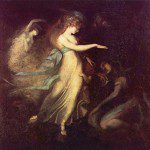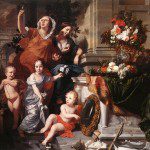
So far in this series, I have spoken rather generally about the broad cultural forces in Western culture that have influenced, and perhaps even produced, a uniquely Modern Paganism. Within the United States, however, there are particular religious tendencies that I believe are responsible for determining the form, if not the content, of communal Pagan religious practice.
It has been, in part, my desire in this project to demonstrate that Contemporary Paganism is not, as some of us would like to claim, a discrete entity, somehow separate and removed from our larger culture, but in fact a particular product of certain cultural forces and our collective reaction to them. So far, I have briefly examined the general saturation of Western Culture going as far back as the Late Medieval era with Classical Greek and Roman thought, and have generally sketched out the role of the Gothic and Romantic literary movements in resuscitating certain Pagan ideals in the late nineteenth and early twentieth centuries. By and large, however, these trends have been largely European, and while American Paganism continues to be deeply indebted to its British and European forebears, I would suggest that there are particularly American forces, especially as concerns the American approach to spirituality and religion, that have played a heavy role in the growth and development of American Paganism, both communally and theologically.
Sarah M. Pike observes:
Neopagans’ view of festivals as spiritual frontiers in the wild is drawn on a thematic that powerfully characterizes American attitudes toward this land. Neopagans tap into the frontier myth that is at the heart of American religious diversity because it help the promise of endless space within which to create a new religious life and community. (2001, p. 18)
Almost from the beginning of European settlement in America, the land was poeticized into the promise of religious freedom and possibility. While Paganism in its modern form is a late addition to the American religious milieu, it certainly seems to build on these same sets of ideas. Indeed, as we in the United States speak about the Pagan religious experience, we tend to characterize it in terms of personal autonomy, freedom of choice, and personal expression. Perhaps this sort of rhetoric is made possible by the ingrained American metaphors of space, frontier, and personal freedom.
In the United States, as in the most of the Western World, Christianity in its various forms represents the dominant form of religious expression. However, even Christianity has suffered some dramatic transformations as a result of its interaction with the broader spiritual ethic of the United States. There has been a broad tendency within the religious life of Americans in general to move away from centralized religious authority and focus on the personal experience of and relationship with divine beings and forces. Within Christianity, this has manifested itself in several ways, from the emigration of the Quakers to the United States to the emergence of the Pentecostal and Apostolic churches (which are gaining increasing relevance worldwide). Unitarian Universalism, which many American Pagans are familiar with because of individual congregations allowing us to use their facilities for our own religious expressions, is itself a uniquely American expression of religious freedom with its almost total lack of dogma and assertion that everyone, universally, is saved.
As such, the plurality of Paganism in the United States can be seen as a further development of religious trends endemic to American culture.
Neopagans thus follow a familiar American path of constructing spiritual space by rejecting the meanings and rituals proposed by culturally dominant Christian churches. Christianity becomes essential as what is rejected – and which rejects – to establish Neopagans’ own identity. (Pike, 2001, p.18)
Even the rejection of Christianity as defining characteristic of American Paganism can be seen when looking at other American religious movements. American Protestantism in general defines itself at least in part in opposition to European Catholicism. Indeed, this antipathy runs so deep that it nearly scuttled John F. Kennedy’s presidential hopes, and subsequently we have not had another Catholic president. Indeed, the American religious community seems generally inclined to define itself in opposition to centralized authority, though this opposition expresses itself in various manners and intensities.
One of American Paganism’s most striking antecedents is the Spiritualist movement of the nineteenth century.
Neopagan festivals are akin to the gatherings of nineteenth-century Spiritualists in their eclecticism and the challenge they represent to more orthodox and established religious practices. Loosely defined organizational structures resisted institutionalization and allowed both groups to accommodate participants from a wide variety of faiths at their gatherings. (Pike, 2001, p. 14-15)
Spiritualism allowed members of diverse faiths to gather together in appreciation of certain shared spiritual experiences. Despite the oddity of Spiritualism, it remained a powerfully Christian movement, even if it was viewed as heretical and dangerous by other contemporary Christians. Amerian Paganism follows the model of both the Spiritualist and Revival movements in the United States of both providing spaces of unity for a variety of fringe or minority religious expressions, while simultaneously sequestering itself away from the larger relgious community.
American Paganism, I assert, expresses the generic religious trend of opposition and difference in a particularly bold way. The average American Pagan is free both of overarching authority and of rigorous dogma. The prevalence of eclecticism in American Paganism further demonstrates the freedom of religious expressions available. Such freedom has produced a number of criticisms both from within and outside of the Pagan community, but the fact that many Pagans themselves feel that they are free to assemble their spirituality as they please without regard to the opinions or criticisms of others says something particular about the way that Americans in general and Pagans specifically have come to characterize personal religious experience.
References:
Pike, S.M. (2001). Earthly bodies, magical selves: Contemporary pagans and the search for community. Berkeley and Los Angeles: University of California Press
Syncretic Electric is published on alternate Fridays. Subscribe via RSS or e-mail!

















